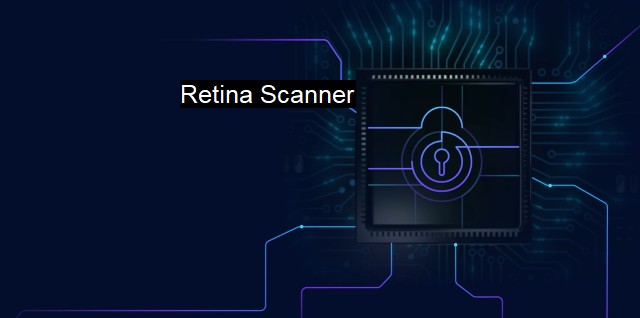What is Retina Scanner?
The Importance of Retina Scanners in Cybersecurity and Antivirus: Explanation, Features, and Uses.
A retina scanner is a cybersecurity tool commonly used in identity authentication processes, particularly in high-security settings such as government organizations, large corporations or financial institutions banking. This fundamental biometric technology records biometric data, specifically, unique patterns in an individual's retinas at the back of their eyes, for use in the verification or recognition system.The human retina acts like fingerprints, displaying a unique biological signature for each individual. This makes retina scanning an incredibly accurate method for recognizing people, surpassing other modes of biometric technology, including palm and fingerprint scanning. Detectors determine the retina's distinguishing patterns by identifying the complex array of blood vessels on the network, burning into the retina; these designs are extraordinarily hard to transform, morph, or disguise, and stay relatively stable over a person’s life.
These scanners function through the use of infrared light to map out the pattern of blood vessels at the back of one's eyes. This pattern remains quite stable over a lifetime, adding to the method's reliability. When the infrared light is shone toward an individual's eyes, it is absorbed by the blood-filled vessels, creating a unique contrast that highlights the distinct network of tiny capillaries residing within the retinal organ. This high-resolution image created by the retina scanner is subsequently digitized and stored in a cybersecurity system.
The accuracy and unforgeable aspect of a retinal scanner widely contribute to its usage within cybersecurity. High-risk data stealing is significantly mitigated, as the system can identify the authorized retina print before permitting any form of access to safeguarded data or protected areas within a building.
As such, among key defensive layers protection, and threat-seeking, this biometric technology marked by retina scanning brings crucial contributions. This brings antivirus software into play, often incorporating biometric data, to spot any potential situations and personalize security measures.
With the evolution of highly sophisticated virus and malware threats, the role of the retina scanner has expanded. Antivirus mechanisms that validate user identities as a protective shield against hackers pose unforeseeable challenges to intruders looking to exploit these systems. Even if cloned, the delicate intricacies of the retinal structure can barely be reproduced, making it nearly impossible for security breaches to occur at points that include retina scanning.
Relatedly, retina scanning technology significantly augments the successful detection, quarantine, and elimination of virus threats. Attaching a specific user ID to each individual session can provide extensive context for system logs, beneficial for analyzing the source or nature of potential threats. during a virus attack, scanning technology can detect any amendments performed towards the retinal image, and give instant alerts regarding potential breaches.
Despite its many benefits, caution is necessary in the use and storage of retina scan data. The very biological uniqueness that makes retina scanning so effective can undermine its viability if the data is abused or breached. Thus, methods for secure storage of this type of biometric data are paramount and constitute an evolving focus within cybersecurity.
Admittedly, nowhere is utterly impervious to ever-evolving cybersecurity threats. with the use of advanced data protection protocols and retina scanning technology expected to become more refined, more accurate, and more secure over years, we can anticipate a future where security barriers are challenging to bypass. This form of biometric identification goes beyond what's been done before, escalating the existing bar of cybersecurity protocols to new heights, ensuring a protected future.
The introduction of retina scanners has reinforced both individual and organizational security systems while enhancing antivirus functions, laying down an effective, enhanced obstacle-course for cyber invaders aiming to manipulate, deceive and disrupt.

Retina Scanner FAQs
What is a retina scanner?
A retina scanner is a biometric device that uses infrared technology to read a person's unique retina pattern. It is commonly used for security and access control purposes in cybersecurity and antivirus systems.How does a retina scanner work?
A retina scanner works by emitting low-power infrared light onto the retina, which reflects back to the scanner and creates a unique digital template of the person's retina pattern. This template is then compared to a database of authorized patterns to determine access control or authentication.Is a retina scanner more secure than a password?
Yes, a retina scanner is generally considered to be more secure than a password since it is much more difficult to replicate or steal a person's retina pattern than it is to guess or steal a password.What are the limitations of using a retina scanner?
One limitation of using a retina scanner is that it requires the user to be in close proximity to the scanner and look directly into it, which may not be practical or convenient in all situations. Additionally, some medical conditions or injuries may affect a person's retina pattern and prevent accurate authentication.| | A | | | B | | | C | | | D | | | E | | | F | | | G | | | H | | | I | | | J | | | K | | | L | | | M | |
| | N | | | O | | | P | | | Q | | | R | | | S | | | T | | | U | | | V | | | W | | | X | | | Y | | | Z | |
| | 1 | | | 2 | | | 3 | | | 4 | | | 7 | | | 8 | | |||||||